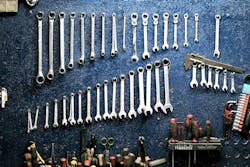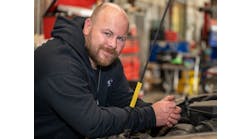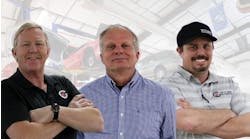With an average on-hand inventory ranging between $3.5 million to $4 million in its 40,000-square-foot parts distribution center, Tom’s Truck Center in Garden Grove, Calif., has the largest inventory of new and used Isuzu parts in the U.S. Tom’s Truck Center averages 6,000 invoices per month, which breaks down to 250–275 invoices per day. With that type of demand and such a massive inventory, it’s essential that the parts department stays on top of its workload.
Peewee Price has been with the company since he graduated from Universal Technical Institute (UTI) in 1982 and has held a number of different positions within the company, including shop foreman and service manager, and has served as Tom’s Truck Center’s parts director for the past 10 years. Price says that his background has allowed him to see the bigger picture in the parts department and keeps him from becoming overwhelmed. While Tom’s Truck Center works primarily with larger trucks, the department works the same as a commercial dealership and the massive inventory has positioned Price an expert in workload management.
Price shares his top tips for keeping his workload under control and maintaining a (relatively) stress-free environment.
Remember: It’s a team effort.
Price’s experience in other positions gives him perspective and a greater understanding of the service department. Instead of just assuming that service is being pushy or demanding, Price recognizes the stress that they’re under to complete a repair on time for a customer, which makes him happy to work for the common good of the company.
“When there’s an issue that arises, we really all have to work together,” Price says. “We’re not two departments working separately—we’re working together.”
Price takes time to get to know everyone in the service department and create relationships with them. He’s learned that the more you know people, the more they’re willing to do for you—and vice versa.
Make sure you have what your customer needs.
Price is the first to admit that he’s very lucky when it comes to his department. Tom’s Truck Center doesn’t have an inventory budget. The owner, K.C. Heidler, doesn’t restrict spending in that area, which allows the department to make sure it has everything its customers need in stock.
For departments that may not have this luxury, Price suggests checking inventory on a consistent basis to make sure you have what the customer wants on stock. Price says this is essential because price is not the most important factor in a customer’s eye—availability is.
Don’t get caught in traffic.
Being located in California where traffic is notoriously bad, Price says that his biggest stressor is transporting parts to customers.
“It’s amazing, at 6 a.m., I can get a customer a part in 40 minutes. If it’s 3:30 and we realize that we sent them the wrong part, it can take over two hours,” Price says.
To avoid getting his staff caught in traffic, Price utilizes FedEx SameDay. Tom’s Trucks has six routes that receive three deliveries per day, which are handled by FedEx. The reason that Tom’s decided to do this is because FedEx provides guaranteed on-time delivery, which Price says is hit 99 percent of the time. If they are off, Price says it’s by a matter of minutes, not hours, which has helped increase Tom’s customer service.
Price also says the company uses Lyft and Uber for deliveries in between the scheduled times if the customer needs it sooner.
Stay on top of inventory.
“We have a large inventory—we have a lot going in and out every day,” Price says.
In order to stay on top of that, Tom’s employes a warehouse manager whose full-time job is inventory control. He uses the company’s CDK DMS to make sure there’s a demand for the part and that the company isn’t bringing in parts that it shouldn’t. By having one person dedicated to inventory, it relieves stress on the department and allows that person to focus completely on building the right inventory.
Plan for special order parts.
Price tries to avoid stocking special order parts when he can because he’s found that it’s the biggest culprit of obsolete parts. However, those parts can’t be avoided altogether.
When a special order part is returned from a customer, Price makes sure to take advantage of any manufacturer returns available, even if he has to pay a restocking fee.
“If I put it back on the shelf, I’m losing the full amount instead of a portion,” Price says.



